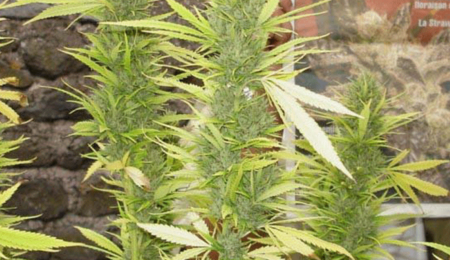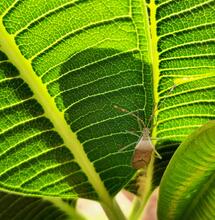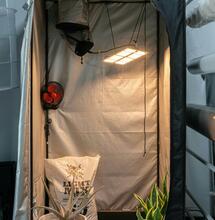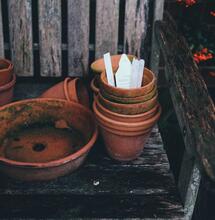Summer Growing Tips
05 May 2019

For those that don’t have the space or inclination to grow indoors, here are a few tips that will ensure the success of this year’s outdoor crop. There are a few tips and practices that should be adhered to. Follow them and this year’s crop will generate enough bud to last all winter. By Thomas Valentine
Planting marijuana just anywhere won’t do. Choosing the proper growing location is of paramount importance to the success of the crop. Whether it is just a few plants or a dozen, it is the location that will ensure success.
The location should be remote enough to keep attentive eyes from finding and possibly destroying the crop. It should have moist soil, but it shouldn’t be wet. Check for standing water near where you’ve chosen. If it is close to the crop area, make sure the standing water isn’t stagnant or soiled. Standing water can poison the local aquifer. Make sure the standing water is at least ten paces from the growing area. Proper drainage is important, since marijuana likes water but doesn’t like growing in standing water - the roots go moldy. If you see insects or even frogs in the standing water, chances are the water is permanent.
Watch for areas with lots of large weeds, as they tend to grow in the same conditions as our favorite green. Clear the area of weeds by pulling up the weed from its roots. Plant in the exposed earth or dig out the area and use a pot filled with growing medium. If there is already a seedling in the pot, don’t take it out - bury the pot. The roots will be damaged no matter how careful it is de-potted.
 Another tip is the growing medium. Since it is not recommended that the crop be visited on a daily basis, the growing medium should be able to hold lots of water. Use a mixture of 50% potting soil, 25% peat, 10% guano and 15% vermiculite. Vermiculite is a white blown glass-like material that holds moisture jealously. Guano, especially bat guano, is simply the manure from any given animal.
Beneficial insects can make or break an outdoor crop. An example of a beneficial insect is a worm. Worm castings are great for the growing medium. The act of pushing itself through the growing medium keeps the material loose and airy. Use four to six worms per pot.
If it is a seed that is being planted make sure the soil is aerated, fluffing it up to allow for the new roots to grow easily through the soil. Aerate down about six inches. Drop a few worms on the fluffed area. They’ll stay in the fluffy earth, since it is easier for them to push through. Don’t fluff the growing area again or there is the risk of damaging the roots. A large and extensive root system is the sign of a very healthy plant.
Since cannabis needs a good supply of moisture, there may come a time when it is necessary to water them artificially. The general rule is that if there is no rain for 3 sunny days, they’ll need to be watered. The idea is to moisten the first inch or so of growing medium to begin with. Start the watering with the closest plant and proceed to the furthest. Wait for the water to be absorbed on the last plant, then work back to the first plant, watering the plants again on the way back. In this way the growing medium will be gently moistened. If lots of water is poured on the plant at once, the risk of exposing the roots goes up. The sudden onrush of cool water will also shock the roots of the plant, slowing down growth until the roots heat up again.
Should the planting area be in a very wild place, the crop will obviously want to be found again. There are a couple of things that can be done for this to happen. Most growers like to place their crop in an off the trail place. It is recommended that a walk of ten minutes into the area that is going to be planted be adhered to. Find the way back to the trail again by dropping 6 inch wide painted stones along the way. Keep dropping stones, with the general rule being that if the last stone cannot be seen, drop another stone. This breadcrumb approach is the simplest way to navigate in a very wild area. If there is dense foliage that blocks the line of sight on the ground, place the colored stone in a tree branch where it bifurcates.
Other ways are to mark the trees or bushes in a way that makes it easy to understand that that is the way to go. If there are no large trees in the area, you might want to tie a sapling in a knot. Another thing you can do is gather some long grass and tie that in a knot. Be creative and realistic and the crop will never be lost.
It is recommended that there be 10 to 12 seedlings planted. Planting this many will result in harvesting 5 or 6 plants at the end of the season. This is because some plants will be lost to animals or insects. Weeding out the male plants will also reduce the number of mature plants when harvest time comes along.
A few words should be given to harvesting your mature cannabis. The easiest and safest way to harvest a mature plant is to cover the erect plant with a big garbage bag, then pull the plant out of the ground by the lowest grasp possible. There should be one plant per bag. Try not to damage any branches, should the strain you’re using may have bud bearing limbs.
These tips will help the crop along immensely. Following these simple rules will make the growing experience an enjoyable and fruitful experience. Be well.
Another tip is the growing medium. Since it is not recommended that the crop be visited on a daily basis, the growing medium should be able to hold lots of water. Use a mixture of 50% potting soil, 25% peat, 10% guano and 15% vermiculite. Vermiculite is a white blown glass-like material that holds moisture jealously. Guano, especially bat guano, is simply the manure from any given animal.
Beneficial insects can make or break an outdoor crop. An example of a beneficial insect is a worm. Worm castings are great for the growing medium. The act of pushing itself through the growing medium keeps the material loose and airy. Use four to six worms per pot.
If it is a seed that is being planted make sure the soil is aerated, fluffing it up to allow for the new roots to grow easily through the soil. Aerate down about six inches. Drop a few worms on the fluffed area. They’ll stay in the fluffy earth, since it is easier for them to push through. Don’t fluff the growing area again or there is the risk of damaging the roots. A large and extensive root system is the sign of a very healthy plant.
Since cannabis needs a good supply of moisture, there may come a time when it is necessary to water them artificially. The general rule is that if there is no rain for 3 sunny days, they’ll need to be watered. The idea is to moisten the first inch or so of growing medium to begin with. Start the watering with the closest plant and proceed to the furthest. Wait for the water to be absorbed on the last plant, then work back to the first plant, watering the plants again on the way back. In this way the growing medium will be gently moistened. If lots of water is poured on the plant at once, the risk of exposing the roots goes up. The sudden onrush of cool water will also shock the roots of the plant, slowing down growth until the roots heat up again.
Should the planting area be in a very wild place, the crop will obviously want to be found again. There are a couple of things that can be done for this to happen. Most growers like to place their crop in an off the trail place. It is recommended that a walk of ten minutes into the area that is going to be planted be adhered to. Find the way back to the trail again by dropping 6 inch wide painted stones along the way. Keep dropping stones, with the general rule being that if the last stone cannot be seen, drop another stone. This breadcrumb approach is the simplest way to navigate in a very wild area. If there is dense foliage that blocks the line of sight on the ground, place the colored stone in a tree branch where it bifurcates.
Other ways are to mark the trees or bushes in a way that makes it easy to understand that that is the way to go. If there are no large trees in the area, you might want to tie a sapling in a knot. Another thing you can do is gather some long grass and tie that in a knot. Be creative and realistic and the crop will never be lost.
It is recommended that there be 10 to 12 seedlings planted. Planting this many will result in harvesting 5 or 6 plants at the end of the season. This is because some plants will be lost to animals or insects. Weeding out the male plants will also reduce the number of mature plants when harvest time comes along.
A few words should be given to harvesting your mature cannabis. The easiest and safest way to harvest a mature plant is to cover the erect plant with a big garbage bag, then pull the plant out of the ground by the lowest grasp possible. There should be one plant per bag. Try not to damage any branches, should the strain you’re using may have bud bearing limbs.
These tips will help the crop along immensely. Following these simple rules will make the growing experience an enjoyable and fruitful experience. Be well.
 Another tip is the growing medium. Since it is not recommended that the crop be visited on a daily basis, the growing medium should be able to hold lots of water. Use a mixture of 50% potting soil, 25% peat, 10% guano and 15% vermiculite. Vermiculite is a white blown glass-like material that holds moisture jealously. Guano, especially bat guano, is simply the manure from any given animal.
Beneficial insects can make or break an outdoor crop. An example of a beneficial insect is a worm. Worm castings are great for the growing medium. The act of pushing itself through the growing medium keeps the material loose and airy. Use four to six worms per pot.
If it is a seed that is being planted make sure the soil is aerated, fluffing it up to allow for the new roots to grow easily through the soil. Aerate down about six inches. Drop a few worms on the fluffed area. They’ll stay in the fluffy earth, since it is easier for them to push through. Don’t fluff the growing area again or there is the risk of damaging the roots. A large and extensive root system is the sign of a very healthy plant.
Since cannabis needs a good supply of moisture, there may come a time when it is necessary to water them artificially. The general rule is that if there is no rain for 3 sunny days, they’ll need to be watered. The idea is to moisten the first inch or so of growing medium to begin with. Start the watering with the closest plant and proceed to the furthest. Wait for the water to be absorbed on the last plant, then work back to the first plant, watering the plants again on the way back. In this way the growing medium will be gently moistened. If lots of water is poured on the plant at once, the risk of exposing the roots goes up. The sudden onrush of cool water will also shock the roots of the plant, slowing down growth until the roots heat up again.
Should the planting area be in a very wild place, the crop will obviously want to be found again. There are a couple of things that can be done for this to happen. Most growers like to place their crop in an off the trail place. It is recommended that a walk of ten minutes into the area that is going to be planted be adhered to. Find the way back to the trail again by dropping 6 inch wide painted stones along the way. Keep dropping stones, with the general rule being that if the last stone cannot be seen, drop another stone. This breadcrumb approach is the simplest way to navigate in a very wild area. If there is dense foliage that blocks the line of sight on the ground, place the colored stone in a tree branch where it bifurcates.
Other ways are to mark the trees or bushes in a way that makes it easy to understand that that is the way to go. If there are no large trees in the area, you might want to tie a sapling in a knot. Another thing you can do is gather some long grass and tie that in a knot. Be creative and realistic and the crop will never be lost.
It is recommended that there be 10 to 12 seedlings planted. Planting this many will result in harvesting 5 or 6 plants at the end of the season. This is because some plants will be lost to animals or insects. Weeding out the male plants will also reduce the number of mature plants when harvest time comes along.
A few words should be given to harvesting your mature cannabis. The easiest and safest way to harvest a mature plant is to cover the erect plant with a big garbage bag, then pull the plant out of the ground by the lowest grasp possible. There should be one plant per bag. Try not to damage any branches, should the strain you’re using may have bud bearing limbs.
These tips will help the crop along immensely. Following these simple rules will make the growing experience an enjoyable and fruitful experience. Be well.
Another tip is the growing medium. Since it is not recommended that the crop be visited on a daily basis, the growing medium should be able to hold lots of water. Use a mixture of 50% potting soil, 25% peat, 10% guano and 15% vermiculite. Vermiculite is a white blown glass-like material that holds moisture jealously. Guano, especially bat guano, is simply the manure from any given animal.
Beneficial insects can make or break an outdoor crop. An example of a beneficial insect is a worm. Worm castings are great for the growing medium. The act of pushing itself through the growing medium keeps the material loose and airy. Use four to six worms per pot.
If it is a seed that is being planted make sure the soil is aerated, fluffing it up to allow for the new roots to grow easily through the soil. Aerate down about six inches. Drop a few worms on the fluffed area. They’ll stay in the fluffy earth, since it is easier for them to push through. Don’t fluff the growing area again or there is the risk of damaging the roots. A large and extensive root system is the sign of a very healthy plant.
Since cannabis needs a good supply of moisture, there may come a time when it is necessary to water them artificially. The general rule is that if there is no rain for 3 sunny days, they’ll need to be watered. The idea is to moisten the first inch or so of growing medium to begin with. Start the watering with the closest plant and proceed to the furthest. Wait for the water to be absorbed on the last plant, then work back to the first plant, watering the plants again on the way back. In this way the growing medium will be gently moistened. If lots of water is poured on the plant at once, the risk of exposing the roots goes up. The sudden onrush of cool water will also shock the roots of the plant, slowing down growth until the roots heat up again.
Should the planting area be in a very wild place, the crop will obviously want to be found again. There are a couple of things that can be done for this to happen. Most growers like to place their crop in an off the trail place. It is recommended that a walk of ten minutes into the area that is going to be planted be adhered to. Find the way back to the trail again by dropping 6 inch wide painted stones along the way. Keep dropping stones, with the general rule being that if the last stone cannot be seen, drop another stone. This breadcrumb approach is the simplest way to navigate in a very wild area. If there is dense foliage that blocks the line of sight on the ground, place the colored stone in a tree branch where it bifurcates.
Other ways are to mark the trees or bushes in a way that makes it easy to understand that that is the way to go. If there are no large trees in the area, you might want to tie a sapling in a knot. Another thing you can do is gather some long grass and tie that in a knot. Be creative and realistic and the crop will never be lost.
It is recommended that there be 10 to 12 seedlings planted. Planting this many will result in harvesting 5 or 6 plants at the end of the season. This is because some plants will be lost to animals or insects. Weeding out the male plants will also reduce the number of mature plants when harvest time comes along.
A few words should be given to harvesting your mature cannabis. The easiest and safest way to harvest a mature plant is to cover the erect plant with a big garbage bag, then pull the plant out of the ground by the lowest grasp possible. There should be one plant per bag. Try not to damage any branches, should the strain you’re using may have bud bearing limbs.
These tips will help the crop along immensely. Following these simple rules will make the growing experience an enjoyable and fruitful experience. Be well.



.png)